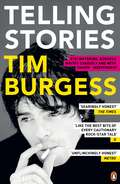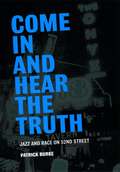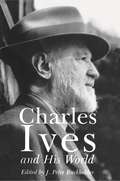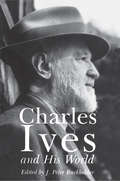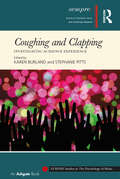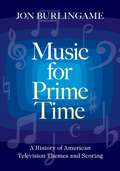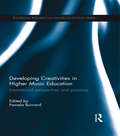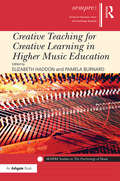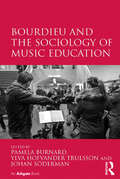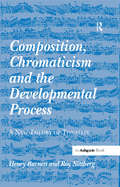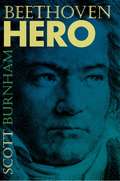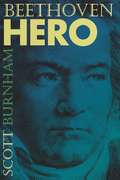- Table View
- List View
Telling Stories
by Tim BurgessTelling Stories by Tim Burgess of The Charlatans is one of the decade's most revealing rock books'Clear, honest. An unusually frank and well-written rock memoir' The TimesThe Charlatans. Madchester. Britpop. Taking on the world. Here are the highs, the lows, the joys, the agonies, and the stories of what it's like to be in a rock band, as told by front man and survivor, Tim Burgess. 'Like the best bits of every cautionary rock star tale . . . there is armed robbery and smuggling. There's serious fraud. There are near and actual death experiences, divorce, industrial cocaine consumption and magnificent cameos from Madonna, Alan McGee, Ronnie Wood, Joe Strummer, LA drug dealer Harry The Dog, and Joaquin Phoenix. A minor classic' QFor readers who enjoyed Life by Keith Richards and Bit of a Blur by Alex James, Telling Stories is one of the finest music books of recent times. It's a story of achievement and survival, from London to LA. 'A vivid read' Independent on Sunday'The Charlatans' frontman recalls the heyday of Britpop and Madchester with endearing exuberance. He's unflinchingly honest about the bad times but also peppers his story with anecdotal nuggets about the pitfalls of rock 'n' roll excess' Metro'Burgess keeps a level head, a sharp eye and a nice turn of phrase' Independent'Written with the stylish flow of a novel - light and dark, hilarious and melancholic' Emma Forrest'For a man whose behaviour borders on the suicidal, Timothy Burgess, the people's friend, is what you call a life enthusiast. He is also mad. It's a much-abused word, mad . . . but he really is proper coo-ee clouds pan-dimensional mad mad' Syliva Patteerson, SkyTim Burgess was born in Salford but grew up in a village near Northwich, Cheshire. Leaving school at 16 to work at ICI, his real love was music and soon afterwards he was invited to join new band The Charlatans. For twelve years Burgess lived in Los Angeles but he has recently returned to the UK.
Tim Book Two: Vinyl Adventures from Istanbul to San Francisco
by Tim BurgessTim Book Two is the follow-up to Telling Stories, the hugely successful memoir of Tim Burgess, singer of the Charlatans. In 2012, Tim published his hugely successful and critically acclaimed memoir, Telling Stories. Tim really enjoyed his new role as an author, and so here it is: Tim Book Two - a tale of Tim's lifelong passion for records, the shops that sell them, and the people who make them. In some ways, the biggest events in Tim's life happened in the couple of years after he had finished writing his first book rather than in the forty years before. So he had more to say, but instead of another autobiography he chose a different way of telling the story. Tim set himself a quest. He would get in touch with people he admired, and ask them to suggest an album for him to track down on his travels, giving an insight into what makes them tick. It would also offer a chance to see how record shops were faring in the digital age - one in which vinyl was still a much-treasured format.Tim assembled his cast of characters, from Iggy Pop to Johnny Marr, David Lynch to Cosey Fanni Tutti. Texts, phone calls, emails and handwritten notes went out. Here is the tender, funny and surprising story of what came back.
Come In and Hear the Truth: Jazz and Race on 52nd Street
by Patrick BurkeBetween the mid-1930s and the late ’40s, the center of the jazz world was a two-block stretch of 52nd Street in Manhattan. Dozens of crowded basement clubs between Fifth and Seventh avenues played host to legends such as Billie Holiday and Charlie Parker, as well as to innumerable professional musicians whose names aren’t quite so well known. Together, these musicians and their audiences defied the traditional border between serious art and commercial entertainment—and between the races, as 52nd Street was home to some of the first nightclubs in New York to allow racially integrated bands and audiences. Patrick Burke argues that the jazz played on 52nd Street complicated simplistic distinctions between musical styles such as Dixieland, swing, and bebop. And since these styles were defined along racial lines, the music was itself a powerful challenge to racist ideology. Come In and Hear the Truth uses a range of materials, from classic photographs to original interviews with musicians, to bring the street’s vibrant history to life and to shed new light on the interracial contacts and collaborations it generated.
Tear Down the Walls: White Radicalism and Black Power in 1960s Rock
by Patrick BurkeFrom the earliest days of rock and roll, white artists regularly achieved fame, wealth, and success that eluded the Black artists whose work had preceded and inspired them. This dynamic continued into the 1960s, even as the music and its fans grew to be more engaged with political issues regarding race. In Tear Down the Walls, Patrick Burke tells the story of white American and British rock musicians’ engagement with Black Power politics and African American music during the volatile years of 1968 and 1969. The book sheds new light on a significant but overlooked facet of 1960s rock—white musicians and audiences casting themselves as political revolutionaries by enacting a romanticized vision of African American identity. These artists’ attempts to cast themselves as revolutionary were often naïve, misguided, or arrogant, but they could also reflect genuine interest in African American music and culture and sincere investment in anti-racist politics. White musicians such as those in popular rock groups Jefferson Airplane, the Rolling Stones, and the MC5, fascinated with Black performance and rhetoric, simultaneously perpetuated a long history of racial appropriation and misrepresentation and made thoughtful, self-aware attempts to respectfully present African American music in forms that white leftists found politically relevant. In Tear Down the Walls Patrick Burke neither condemns white rock musicians as inauthentic nor elevates them as revolutionary. The result is a fresh look at 1960s rock that provides new insight into how popular music both reflects and informs our ideas about race and how white musicians and activists can engage meaningfully with Black political movements.
Tear Down the Walls: White Radicalism and Black Power in 1960s Rock
by Patrick BurkeFrom the earliest days of rock and roll, white artists regularly achieved fame, wealth, and success that eluded the Black artists whose work had preceded and inspired them. This dynamic continued into the 1960s, even as the music and its fans grew to be more engaged with political issues regarding race. In Tear Down the Walls, Patrick Burke tells the story of white American and British rock musicians’ engagement with Black Power politics and African American music during the volatile years of 1968 and 1969. The book sheds new light on a significant but overlooked facet of 1960s rock—white musicians and audiences casting themselves as political revolutionaries by enacting a romanticized vision of African American identity. These artists’ attempts to cast themselves as revolutionary were often naïve, misguided, or arrogant, but they could also reflect genuine interest in African American music and culture and sincere investment in anti-racist politics. White musicians such as those in popular rock groups Jefferson Airplane, the Rolling Stones, and the MC5, fascinated with Black performance and rhetoric, simultaneously perpetuated a long history of racial appropriation and misrepresentation and made thoughtful, self-aware attempts to respectfully present African American music in forms that white leftists found politically relevant. In Tear Down the Walls Patrick Burke neither condemns white rock musicians as inauthentic nor elevates them as revolutionary. The result is a fresh look at 1960s rock that provides new insight into how popular music both reflects and informs our ideas about race and how white musicians and activists can engage meaningfully with Black political movements.
Charles Ives and His World: Charles Ives And The Uses Of Musical Borrowing (The Bard Music Festival #51)
by J. BurkholderThis volume shows Charles Ives in the context of his world in a number of revealing ways. Five new essays examine Ives's relationships to European music and to American music, politics, business, and landscape. J. Peter Burkholder shows Ives as a composer well versed in four distinctive musical traditions who blended them in his mature music. Leon Botstein explores the paradox of how, in the works of Ives and Mahler, musical modernism emerges from profoundly antimodern sensibilities. David Michael Hertz reveals unsuspected parallels between one of Ives's most famous pieces, the Concord Piano Sonata, and the piano sonatas of Liszt and Scriabin. Michael Broyles sheds new light on Ives's political orientation and on his career in the insurance business, and Mark Tucker shows the importance for Ives of his vacations in the Adirondacks and the representation of that landscape in his music. The remainder of the book presents documents that illuminate Ives's personal life. A selection of some sixty letters to and from Ives and his family, edited and annotated by Tom C. Owens, is the first substantial collection of Ives correspondence to be published. Two sections of reviews and longer profiles published during his lifetime highlight the important stages in the reception of Ives's music, from his early works through the premieres of his most important compositions to his elevation as an almost mythic figure with a reputation among some critics as America's greatest composer.
Charles Ives and His World (The Bard Music Festival: 7) (PDF)
by J. BurkholderThis volume shows Charles Ives in the context of his world in a number of revealing ways. Five new essays examine Ives's relationships to European music and to American music, politics, business, and landscape. J. Peter Burkholder shows Ives as a composer well versed in four distinctive musical traditions who blended them in his mature music. Leon Botstein explores the paradox of how, in the works of Ives and Mahler, musical modernism emerges from profoundly antimodern sensibilities. David Michael Hertz reveals unsuspected parallels between one of Ives's most famous pieces, the Concord Piano Sonata, and the piano sonatas of Liszt and Scriabin. Michael Broyles sheds new light on Ives's political orientation and on his career in the insurance business, and Mark Tucker shows the importance for Ives of his vacations in the Adirondacks and the representation of that landscape in his music. The remainder of the book presents documents that illuminate Ives's personal life. A selection of some sixty letters to and from Ives and his family, edited and annotated by Tom C. Owens, is the first substantial collection of Ives correspondence to be published. Two sections of reviews and longer profiles published during his lifetime highlight the important stages in the reception of Ives's music, from his early works through the premieres of his most important compositions to his elevation as an almost mythic figure with a reputation among some critics as America's greatest composer.
Coughing and Clapping: Investigating Audience Experience (SEMPRE Studies in The Psychology of Music)
by Karen Burland Stephanie PittsCoughing and Clapping: Investigating Audience Experience explores the processes and experiences of attending live music events from the initial decision to attend through to audience responses and memories of a performance after it has happened. The book brings together international researchers who consider the experience of being an audience member from a range of theoretical and empirical perspectives. Whether enjoying a drink at a jazz gig, tweeting at a pop concert or suppressing a cough at a classical recital, audience experience is affected by motivation, performance quality, social atmosphere and group and personal identity. Drawing on the implications of these experiences and attitudes, the authors consider the question of what makes an audience, and argue convincingly for the practical and academic value of that question.
Coughing and Clapping: Investigating Audience Experience (SEMPRE Studies in The Psychology of Music)
by Karen Burland Stephanie PittsCoughing and Clapping: Investigating Audience Experience explores the processes and experiences of attending live music events from the initial decision to attend through to audience responses and memories of a performance after it has happened. The book brings together international researchers who consider the experience of being an audience member from a range of theoretical and empirical perspectives. Whether enjoying a drink at a jazz gig, tweeting at a pop concert or suppressing a cough at a classical recital, audience experience is affected by motivation, performance quality, social atmosphere and group and personal identity. Drawing on the implications of these experiences and attitudes, the authors consider the question of what makes an audience, and argue convincingly for the practical and academic value of that question.
Music for Prime Time: A History of American Television Themes and Scoring
by Jon BurlingameWith hundreds of interviews conducted over a 35-year span, this book is the most comprehensive history of television scoring to date. Music composed for television had, until recently, never been taken seriously by scholars or critics. Catchy TV themes, often for popular weekly series, were fondly remembered but not considered much more culturally significant than commercial jingles. Yet noted composers like John Williams, Henry Mancini, Jerry Goldsmith and Lalo Schifrin learned and/or honed their craft in television before going on to major success in feature films. Oscar-winning film composers like Bernard Herrmann, Franz Waxman and Maurice Jarre wrote hours of music for television projects, and such high-profile jazz figures as Duke Ellington, Dave Brubeck and Quincy Jones also contributed music to TV series. Concert-hall luminaries from Aaron Copland to Leonard Bernstein, and theater writers from Jerome Moross to Richard Rodgers, penned memorable scores for TV. Music for Prime Time is the first serious, journalistic history of music for American television. It is the product of 35 years of research and more than 450 interviews with composers, orchestrators, producers, editors and musicians active in the field. Based on, but vastly expanded and revised from, an earlier book by the same author, this wide-ranging narrative not only tells the backstory of every great TV theme but also examines the many neglected and frequently underrated orchestral and jazz compositions for television dating back to the late 1940s. Covering every series genre (crime, comedy, drama, westerns, action-adventure, fantasy and sci-fi), it also looks at music for animated series, news and documentary programming, TV-movies and miniseries, and how music for television has evolved in the era of cable and streaming options. It is the most comprehensive history of television scoring ever published.
Music for Prime Time: A History of American Television Themes and Scoring
by Jon BurlingameWith hundreds of interviews conducted over a 35-year span, this book is the most comprehensive history of television scoring to date. Music composed for television had, until recently, never been taken seriously by scholars or critics. Catchy TV themes, often for popular weekly series, were fondly remembered but not considered much more culturally significant than commercial jingles. Yet noted composers like John Williams, Henry Mancini, Jerry Goldsmith and Lalo Schifrin learned and/or honed their craft in television before going on to major success in feature films. Oscar-winning film composers like Bernard Herrmann, Franz Waxman and Maurice Jarre wrote hours of music for television projects, and such high-profile jazz figures as Duke Ellington, Dave Brubeck and Quincy Jones also contributed music to TV series. Concert-hall luminaries from Aaron Copland to Leonard Bernstein, and theater writers from Jerome Moross to Richard Rodgers, penned memorable scores for TV. Music for Prime Time is the first serious, journalistic history of music for American television. It is the product of 35 years of research and more than 450 interviews with composers, orchestrators, producers, editors and musicians active in the field. Based on, but vastly expanded and revised from, an earlier book by the same author, this wide-ranging narrative not only tells the backstory of every great TV theme but also examines the many neglected and frequently underrated orchestral and jazz compositions for television dating back to the late 1940s. Covering every series genre (crime, comedy, drama, westerns, action-adventure, fantasy and sci-fi), it also looks at music for animated series, news and documentary programming, TV-movies and miniseries, and how music for television has evolved in the era of cable and streaming options. It is the most comprehensive history of television scoring ever published.
Developing Creativities in Higher Music Education: International Perspectives and Practices (Routledge Research in Higher Education)
by Pamela BurnardThis is the first book to critically address the issue of how we can enhance and develop creativities in higher music education. It features new international, richly diverse perspectives on the nature and practice of creativities in different cultural and institutional contexts, in varying roles and in response to diverse professional pressures and expectations of artistic and educational achievement. This compelling and provocative book combines powerful social and educational commentaries and examples drawn from international sources based on original practices and experience of a diversity of creativities. The authors provide an important contribution by drawing attention to what is at the heart of all music and how we can understand and foster these multiple creativities at an individual and institutional level. It features new analyses of the question of creativities in higher music education, and offers illustrative and innovative examples of adaptive learning environments for teaching and learning creatively, considering the broader issue of the role of creativities in relation to educational policy in the context of increasingly interventionist governments and rapidly paced educational change. Topics covered include: -the conceptual tools for people to think about and debate multiple creativities -the role of creativities in higher music education-how musicians can develop multiple creativities in new ways -new approaches to teaching and learning for multiple creativities -what constitute leadership creativities in conservatoires and music departments-creativities at the interface of institutional learning cultures-assessing the multiple creativities of music. Developing Creativities in Higher Music Education offers a multi-disciplinary research and practice focus, which will be essential reading for anyone involved in higher education and industry sectors. The book will appeal to academics and practitioners in music, researchers, instrumental and vocal teachers, curriculum and policy developers and institutional managers who want to enrich the higher education experiences of their students and enable them to develop more of their creative potential. It is also ideal reading for undergraduate and postgraduate students of music education who are looking for an authoritative selection of writings that define the fields of musical creativities in one comprehensive volume.
Developing Creativities in Higher Music Education: International Perspectives and Practices (Routledge Research in Higher Education)
by Pamela BurnardThis is the first book to critically address the issue of how we can enhance and develop creativities in higher music education. It features new international, richly diverse perspectives on the nature and practice of creativities in different cultural and institutional contexts, in varying roles and in response to diverse professional pressures and expectations of artistic and educational achievement. This compelling and provocative book combines powerful social and educational commentaries and examples drawn from international sources based on original practices and experience of a diversity of creativities. The authors provide an important contribution by drawing attention to what is at the heart of all music and how we can understand and foster these multiple creativities at an individual and institutional level. It features new analyses of the question of creativities in higher music education, and offers illustrative and innovative examples of adaptive learning environments for teaching and learning creatively, considering the broader issue of the role of creativities in relation to educational policy in the context of increasingly interventionist governments and rapidly paced educational change. Topics covered include: -the conceptual tools for people to think about and debate multiple creativities -the role of creativities in higher music education-how musicians can develop multiple creativities in new ways -new approaches to teaching and learning for multiple creativities -what constitute leadership creativities in conservatoires and music departments-creativities at the interface of institutional learning cultures-assessing the multiple creativities of music. Developing Creativities in Higher Music Education offers a multi-disciplinary research and practice focus, which will be essential reading for anyone involved in higher education and industry sectors. The book will appeal to academics and practitioners in music, researchers, instrumental and vocal teachers, curriculum and policy developers and institutional managers who want to enrich the higher education experiences of their students and enable them to develop more of their creative potential. It is also ideal reading for undergraduate and postgraduate students of music education who are looking for an authoritative selection of writings that define the fields of musical creativities in one comprehensive volume.
Professional Knowledge in Music Teacher Education
by Pamela BurnardThe complexity of the various forms of knowledge and practices that are encountered by teachers, university lecturers, teacher trainers, student teachers, policy makers and researchers, demands careful thought and reflection. Professional Knowledge in Music Teacher Education focuses on how knowledge is understood, what theories are held and the related assumptions that are made about teachers and learners, as well as how theory and practice can be understood, with useful and imaginative connections made between the two in music teacher education. Internationally renowned contributors address a number of fundamental questions designed to take the reader to the heart of current debates around knowledge, practice, professionalism, and learning and teaching in music as well as considering how all these elements are influenced by economic, cultural and social forces. The book demonstrates how research can inform pedagogical approaches in music teacher education; methods, courses and field experiences, and prepare teachers for diverse learners from a range of educational settings. The book will appeal to those interested in the development of appropriate professional knowledge and pedagogic practices in music teacher education.
Professional Knowledge in Music Teacher Education
by Pamela BurnardThe complexity of the various forms of knowledge and practices that are encountered by teachers, university lecturers, teacher trainers, student teachers, policy makers and researchers, demands careful thought and reflection. Professional Knowledge in Music Teacher Education focuses on how knowledge is understood, what theories are held and the related assumptions that are made about teachers and learners, as well as how theory and practice can be understood, with useful and imaginative connections made between the two in music teacher education. Internationally renowned contributors address a number of fundamental questions designed to take the reader to the heart of current debates around knowledge, practice, professionalism, and learning and teaching in music as well as considering how all these elements are influenced by economic, cultural and social forces. The book demonstrates how research can inform pedagogical approaches in music teacher education; methods, courses and field experiences, and prepare teachers for diverse learners from a range of educational settings. The book will appeal to those interested in the development of appropriate professional knowledge and pedagogic practices in music teacher education.
Creative Teaching for Creative Learning in Higher Music Education (SEMPRE Studies in The Psychology of Music)
by Pamela Burnard Elizabeth HaddonThis edited volume explores how selected researchers, students and academics name and frame creative teaching and learning as constructed through the rationalities, practices, relationships, events, objects and systems that are brought to educational sites and developed by learning communities. The concept of creative learning questions the starting-points and opens up the outcomes of curriculum, and this frames creative teaching not only as a process of learning but as an agent of change. Within the book, the various creativities that are valued by different stakeholders teaching and studying in the higher music sector are delineated, and processes and understandings of creative teaching are articulated, both generally in higher music education and specifically through their application within the design of individual modules. This focus makes the text relevant to scholars, researchers and practitioners across many fields of music, including those working in musicology, composition, performance, music education, and music psychology. The book contributes new perspectives on our understanding of the role of creative teaching and learning and processes in creative teaching across the domain of music learning in higher music education sectors.
Creative Teaching for Creative Learning in Higher Music Education (SEMPRE Studies in The Psychology of Music)
by Pamela Burnard Elizabeth HaddonThis edited volume explores how selected researchers, students and academics name and frame creative teaching and learning as constructed through the rationalities, practices, relationships, events, objects and systems that are brought to educational sites and developed by learning communities. The concept of creative learning questions the starting-points and opens up the outcomes of curriculum, and this frames creative teaching not only as a process of learning but as an agent of change. Within the book, the various creativities that are valued by different stakeholders teaching and studying in the higher music sector are delineated, and processes and understandings of creative teaching are articulated, both generally in higher music education and specifically through their application within the design of individual modules. This focus makes the text relevant to scholars, researchers and practitioners across many fields of music, including those working in musicology, composition, performance, music education, and music psychology. The book contributes new perspectives on our understanding of the role of creative teaching and learning and processes in creative teaching across the domain of music learning in higher music education sectors.
Bourdieu and the Sociology of Music Education
by Pamela Burnard Ylva Hofvander TrulssonPierre Bourdieu has been an extraordinarily influential figure in the sociology of music. For over four decades, his concepts have helped to generate both empirical and theoretical interventions in the field of musical study. His impact on the sociology of music taste, in particular, has been profound, his ideas directly informing our understandings of how musical preferences reflect and reproduce inequalities between social classes, ethnic groups, and men and women. Bourdieu and the Sociology of Music Education draws together a group of international researchers, academics and artist-practitioners who offer a critical introduction and exploration of Pierre Bourdieu’s rich generative conceptual tools for advancing sociological views of music education. By employing perspectives from Bourdieu’s work on distinction and judgement and his conceptualisation of fields, habitus and capitals in relation to music education, contributing authors explore the ways in which Bourdieu’s work can be applied to music education as a means of linking school (institutional habitus) and learning, and curriculum and family (class habitus). The volume includes research perspectives and studies of how Bourdieu’s tools have been applied in industry and educational contexts, including the primary, secondary and higher music education sectors. The volume begins with an introduction to Bourdieu’s contribution to theory and methodology and then goes on to deal in detail with illustrative substantive studies. The concluding chapter is an extended essay that reflects on, and critiques, the application of Bourdieu’s work and examines the ways in which the studies contained in the volume advance understanding. The book contributes new perspectives to our understanding of Bourdieu’s tools across diverse settings and practices of music education.
Bourdieu and the Sociology of Music Education
by Pamela Burnard Ylva Hofvander TrulssonPierre Bourdieu has been an extraordinarily influential figure in the sociology of music. For over four decades, his concepts have helped to generate both empirical and theoretical interventions in the field of musical study. His impact on the sociology of music taste, in particular, has been profound, his ideas directly informing our understandings of how musical preferences reflect and reproduce inequalities between social classes, ethnic groups, and men and women. Bourdieu and the Sociology of Music Education draws together a group of international researchers, academics and artist-practitioners who offer a critical introduction and exploration of Pierre Bourdieu’s rich generative conceptual tools for advancing sociological views of music education. By employing perspectives from Bourdieu’s work on distinction and judgement and his conceptualisation of fields, habitus and capitals in relation to music education, contributing authors explore the ways in which Bourdieu’s work can be applied to music education as a means of linking school (institutional habitus) and learning, and curriculum and family (class habitus). The volume includes research perspectives and studies of how Bourdieu’s tools have been applied in industry and educational contexts, including the primary, secondary and higher music education sectors. The volume begins with an introduction to Bourdieu’s contribution to theory and methodology and then goes on to deal in detail with illustrative substantive studies. The concluding chapter is an extended essay that reflects on, and critiques, the application of Bourdieu’s work and examines the ways in which the studies contained in the volume advance understanding. The book contributes new perspectives to our understanding of Bourdieu’s tools across diverse settings and practices of music education.
Composition, Chromaticism and the Developmental Process: A New Theory of Tonality
by Henry BurnettMusicology, having been transmitted as a compilation of disparate events and disciplines, has long necessitated a 'magic bullet', a 'unified field theory' so to speak, that can interpret the steady metamorphosis of Western art music from late medieval modality to twentieth-century atonality within a single theoretical construct. Without that magic bullet, discussions of this kind are increasingly complicated and, to make matters worse, the validity of any transformational models and ideas of the natural evolution of styles is questioned and even frowned upon today as epitomizing a grotesque teleological bigotry. Going against current thinking, Henry Burnett and Roy Nitzberg claim that the teleological approach to observing stylistic change is still valid when considered from the purely compositional perspective. The authors challenge the traditional understanding of development, and advance a new theory of eleven-pitch tonality as it relates to the corpus of Western composition. The book plots the evolution of tonality and its bearing on style and the compositional process itself. The theory is not based on the diatonic aspect of the various tonal systems exploited by composers; rather, the theory is chromatically based - the chromatically inflected octave being the source not only of a highly ingenious developmental dialectic, but also encompassing the moment-to-moment progression of the musical narrative itself. Even the most profound teachings of Schenker, and the often startlingly original and worthwhile speculations of Riemann, Tovey, Dahlhaus and others, still provide no theory of development and so are ultimately unable to unite the various tendrils of the compositional organism into a unified whole. Burnett and Nitzberg move beyond existing theory and analysis to base their theory from the standpoint of chromatic 'pitch fields'. These fields are the specific chromatic pitch choices that a composer uses to inform and design a complete composition, utilizing
Composition, Chromaticism and the Developmental Process: A New Theory of Tonality
by Henry BurnettMusicology, having been transmitted as a compilation of disparate events and disciplines, has long necessitated a 'magic bullet', a 'unified field theory' so to speak, that can interpret the steady metamorphosis of Western art music from late medieval modality to twentieth-century atonality within a single theoretical construct. Without that magic bullet, discussions of this kind are increasingly complicated and, to make matters worse, the validity of any transformational models and ideas of the natural evolution of styles is questioned and even frowned upon today as epitomizing a grotesque teleological bigotry. Going against current thinking, Henry Burnett and Roy Nitzberg claim that the teleological approach to observing stylistic change is still valid when considered from the purely compositional perspective. The authors challenge the traditional understanding of development, and advance a new theory of eleven-pitch tonality as it relates to the corpus of Western composition. The book plots the evolution of tonality and its bearing on style and the compositional process itself. The theory is not based on the diatonic aspect of the various tonal systems exploited by composers; rather, the theory is chromatically based - the chromatically inflected octave being the source not only of a highly ingenious developmental dialectic, but also encompassing the moment-to-moment progression of the musical narrative itself. Even the most profound teachings of Schenker, and the often startlingly original and worthwhile speculations of Riemann, Tovey, Dahlhaus and others, still provide no theory of development and so are ultimately unable to unite the various tendrils of the compositional organism into a unified whole. Burnett and Nitzberg move beyond existing theory and analysis to base their theory from the standpoint of chromatic 'pitch fields'. These fields are the specific chromatic pitch choices that a composer uses to inform and design a complete composition, utilizing
Beethoven Hero
by Scott BurnhamBringing together reception history, music analysis and criticism, the history of music theory, and the philosophy of music, Beethoven Hero explores the nature and persistence of Beethoven's heroic style. What have we come to value in this music, asks Scott Burnham, and why do generations of critics and analysts hear it in much the same way? Specifically, what is it that fosters the intensity of listener engagement with the heroic style, the often overwhelming sense of identification with its musical process? Starting with the story of heroic quest heard time and again in the first movement of the Eroica Symphony, Burnham suggests that Beethoven's music matters profoundly to its listeners because it projects an empowering sense of self, destiny, and freedom, while modeling ironic self-consciousness. In addition to thus identifying Beethoven's music as an overarching expression of values central to the age of Goethe and Hegel, the author describes and then critiques the process by which the musical values of the heroic style quickly became the controlling model of compositional logic in Western music criticism and analysis. Apart from its importance for students of Beethoven, this book will appeal to those interested in canon formation in the arts and in music as a cultural, ethical, and emotional force--and to anyone concerned with what we want from music and what music does for us.
Beethoven Hero (PDF)
by Scott BurnhamBringing together reception history, music analysis and criticism, the history of music theory, and the philosophy of music, Beethoven Hero explores the nature and persistence of Beethoven's heroic style. What have we come to value in this music, asks Scott Burnham, and why do generations of critics and analysts hear it in much the same way? Specifically, what is it that fosters the intensity of listener engagement with the heroic style, the often overwhelming sense of identification with its musical process? Starting with the story of heroic quest heard time and again in the first movement of the Eroica Symphony, Burnham suggests that Beethoven's music matters profoundly to its listeners because it projects an empowering sense of self, destiny, and freedom, while modeling ironic self-consciousness. In addition to thus identifying Beethoven's music as an overarching expression of values central to the age of Goethe and Hegel, the author describes and then critiques the process by which the musical values of the heroic style quickly became the controlling model of compositional logic in Western music criticism and analysis. Apart from its importance for students of Beethoven, this book will appeal to those interested in canon formation in the arts and in music as a cultural, ethical, and emotional force--and to anyone concerned with what we want from music and what music does for us.
